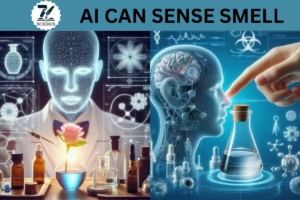In the recent era, artificial intelligence (AI) has made considerable advancements in replicating human senses. While much of the interest has focused on vision and sound, a revolutionary advancement is appearing in the world of smell. We see that exactly artificial intelligence (AI) can smell. This concept could seem like science fiction, but AI-based systems are turning it into an actuality. In this article, we’ll analyze how AI can smell, what it indicates for various sectors, and how it could influence our lives.

Understanding the Science of Smell
Before exploring AI’s power to “smell,” it is important to understand how humans and living things sense smells. Our sense of smell, known as olfaction, functions using specific cells in the nose. These cells sense chemical substances in the atmosphere, which are then sent to the brain through different sensory neurons, where they are analyzed as unique smells.
Humans can detect a large number of distinct fragrances, and our sense of smell contributes a vital role in all things from taste to memory. But, our ability to identify and distinguish fragrances is limited as compared to some animals, such as dogs, and cats who have a much more advanced sense of scent.
How Does AI “Smell”?
AI does not have a smell organ or the biological structures that humans and animals use for scent identification. Rather, it uses detectors and modern algorithms to replicate the process of smelling. Scientists and designers have designed systems that can Identify chemical substances in the air and analyze them in a way that replicates how we sense smells.
The technology depends on two fundamental components: sensors and machine learning.
1. Sensors
Artificial Intelligence systems customized to “scent” usually use a variety of sensors that can sense various kinds of particles. These sensors are sometimes known as “electronic noses.” They use various chemical sensors to detect the occurrence of particular substances in the atmosphere. Once the sensors sense these compounds, the data is analyzed by AI algorithms. Some of the sensors are designed to detect a wide range of smells, on the other hand, others are designed for different chemicals, such as those found in food, perfumes, or smog.
2. Machine Learning
After the sensors sense specific chemical substances, AI( Artificial Intelligence) algorithms activate to interpret and analyze the data. These algorithms are trained using extensive collections of smells and related molecular signatures. Gradually, the system understands how to recognize structures and organize distinct smells based on their chemical structure.
For instance, the machine learning model might be trained to detect the scent of sweet fragrances, roses, or even more complicated smells like smoke or petrol fumes. As it gets updated data, the system consistently Improves its ability to detect and classify smells more correctly.
Uses of AI That Can Smell
The emerging uses of AI in the field of smell are extensive. Let’s explore some sectors where AI’s ability to scent could have an important Influence.
Food and Drink Industry:
AI can be a turning point for the food industry. In the manufacturing of food and drinks, readability and standards are significant. AI-based fragrance detection systems can help identify spoilage, purity, or even the presence of particular materials during manufacturing.
For example, if we are making coffee or processing alcoholic drinks, AI can detect the articular substances mitted during the activity and help ensure the Item fulfills quality standards. If something is wrong, the AI can inform the producer before the product reaches the counters, reducing both time and money.
AI can also be used in food health. Spoiled food usually releases particular scents, and AI can be trained to detect these smells early in production, preventing potentially dangerous products from arriving at customers.

Healthcare
In healthcare, AI that can scent contains vast potential. Automated olfactory sensors are being designed to recognize evaporating organic compounds in human breath or moisture, which can reveal the existence of diseases such as cancer, diabetes, or infections. These compounds modify in minor ways when an individual is diseased, and AI can quickly evaluate these changes to identify diseases early—commonly before conventional signs show. This authorizes early action and more successful treatment. furthermore, AI can also be used for continuous health monitoring, delivering real-time information for people with long-term disorders like diabetes, guiding them to handle their health more efficiently.
Role in Environmental Protection
The environmental inspecting field is also getting benefits from AI’s smelling skills. AI-powered artificial noses can identify toxic gases, substances, and wastes in the atmosphere, giving immediate data on air quality. This technology is essential for urban areas and enterprises working to minimize pollution and enhance public health. AI can also recognize dangerous material discharges or releases, facilitating for stopping of environmental crises and ensuring obedience to standards. With its ability to observe air quality and identify harmful elements, AI is playing a crucial role in better and safer environments.
Read more
Transform Your Future with Skillshare: A Platform for Lifelong Learning
Artificial Intelligence and Education: Revolutionizing Learning in the Digital Age
Emerging Technologies That Will Change the World
Science & Technology Benefits – Unlock the Hidden With 7scribes
Generation of Computer: Computing Through the Ages